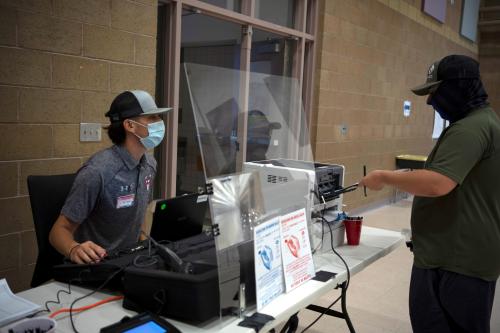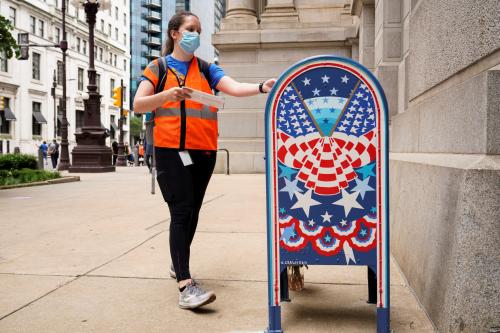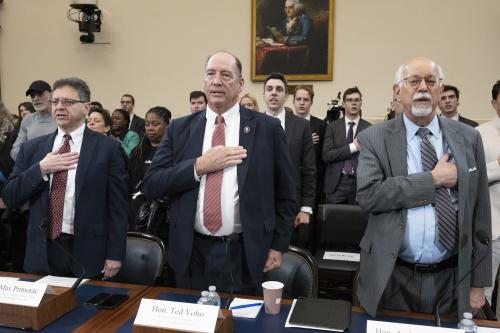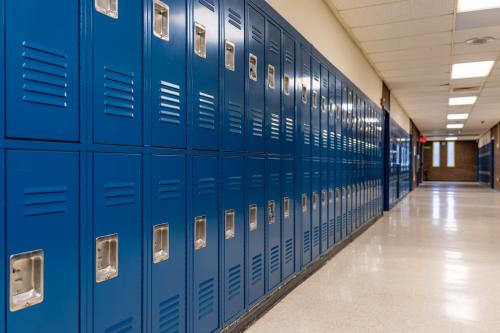Donald Trump has spent the last few months issuing dire warnings about the use of mail-in ballots in November’s election. None of them are supported by facts, but that hasn’t stopped him in the past and it won’t stop him now.
So in light of the president’s false statements, let’s have a look at what to expect in November.
#1: The Postal Service should be fine.
The Postal Service handles 472.1 million pieces of mail every day. Let’s suppose we have voter turnout rates in November of 67.5%. That would be the highest turnout since the election of 1908, and it could very well happen given the high levels of interest in this campaign. There are 235,096,816 eligible voters in the United States—American citizens over the age of 18. That means there could be as many as 158,690,350 million voters in November.
Let’s assume, based on voting behavior in the primaries, that 50% of these voters vote by mail. That would generate just under 80 million mail ballots to be delivered, or a 17% increase over daily mail delivery. Of course, not all these ballots would be mailed on the same day. They would probably be mailed over the course of three or four weeks, further reducing the burden on the Postal Service. To further place this in context, last year the Postal Service delivered 611 million pieces of mail on December 21—the busiest day of the holiday season.
It looked like Trump’s postmaster general tried his best to reduce the capacity of the Postal Service to do its job. But quick action by the House of Representatives and a recent court order seem to have reversed, at least in part, actions that would have slowed down the mail in November.
#2: The prospect of fraud is grossly over-rated.
Trump maintains that other countries will print millions of phony ballots and send them in.
RIGGED 2020 ELECTION: MILLIONS OF MAIL-IN BALLOTS WILL BE PRINTED BY FOREIGN COUNTRIES, AND OTHERS. IT WILL BE THE SCANDAL OF OUR TIMES!
— Donald J. Trump (@realDonaldTrump) June 22, 2020
Trump’s narcissism misleads him here. He is not the only person on the ballot. In addition to the president there are Senate candidates, House candidates, candidates for mayor and city council, candidates for register of probate, and local ballot initiatives to vote on. Because there are many people and issues on the ballot, ballots are not printed nationally or even by states. Voting jurisdictions, of which there are thousands, contract with companies that specialize in securely printing ballots and matching them with voter records. They are printed on certain types of paper, they list many different offices and the names of many candidates. They have a unique design and the return envelopes are usually bar coded. Local election officials will be able to spot phony ballots right away.
There is simply no historical evidence to support the claim that mail-in balloting is inaccurate and fraudulent. The Heritage Foundation, a right-wing think tank, set out to prove that voter fraud was widespread by looking at all the cases they could find state by state. To support the fraud story, they collected data that spanned decades during which millions of votes were cast and found only 1285 cases of voter fraud. We combed through the Heritage data to look specifically at voter fraud related to absentee and mail-in ballots. Here’s a summary:
| Total cases involving absentee and/or mail ballots, or duplicate voting | 309 |
| Cases generating 1 fraudulent vote | 138 |
| Cases generating 2 or more fraudulent votes | 162 |
| Timeframe of sample | 1982-2018 |
| Ballots cast in sample period and states | 1,826,807,464 |
Source: Heritage Foundation data, June 2020.
They looked for fraud over a 36-year period and could only find 1285 cases out of nearly two billion votes cast. That amounts to a rate of .0000007%—not exactly a threat to free and fair elections.
Furthermore, every state has a method of checking the legitimacy of a mail ballot. Mail-in ballots must be signed and election administrators compare the signature on the ballot with the signature on the voter registration form on file. States also take care to note who has already voted absentee; those who have are stricken from the rolls on Election Day and not allowed to vote. Nonetheless, if the election in a given state is close, get ready for lots of challenges to ballots over signatures.
#3: Buckle up for a potentially wild election night, and then a long wait.
Because Trump has been disparaging mail-in voting, polls are showing that Republicans are more likely to vote in person and Democrats are more likely to vote by mail. This has raised the worrisome prospect that the winner on election night might not be the winner a few days later when the absentee ballots are counted. As the count drags on, uncertainty about the outcome could generate conspiracy theories that weaken trust of the whole system—especially in places where the margins are razor-thin.
However, there are reasons to believe that we may know the results in some key states on election night or the day after. First, a majority of states allow absentee ballots to be “processed” prior to Election Day. That means opening the envelopes and checking to see that the signature matches the signature on file. This is a time-consuming step and being able to get a head start helps election officials avoid a bottleneck on Election Day.
Second, states have a variety of laws in place as to when ballots can actually be “counted” as opposed to “processed.” In those states, the ballot are counted but totals are not released until after polls close on election night. In this polarized country, many states are not likely to be close; they are very likely to be safe for Biden or safe for Trump. This election, not unlike others, will come down to a handful of swing states. So, let’s have a look at ten states which are often placed in the toss-up category and which account for 149 electoral college votes. The following table shows when these states will start counting ballots.
When Swing States will Start Counting Ballots
| When mail-in ballots start being counted | Swing state | Electoral votes |
| 22 days before Election Day | Florida | 29 |
| 4 days before Election Day | Arizona | 11 |
| North Carolina | 15 | |
| 1 day before Election Day | Michigan* |
16
|
| Before Election Day, but date not specified | Ohio | 18 |
| POLLS OPEN | ||
| After the polls open on Election Day | Georgia | 16 |
| Pennsylvania* | 20 | |
| Wisconsin | 10 | |
| POLLS CLOSE | ||
| After the polls close on Election Day | Minnesota | 10 |
| New Hampshire | 4 | |
Source: National Conference of State Legislatures; Michigan data is from the Detroit Free Press.
* Legislation is pending in Pennsylvania and Michigan to allow processing of ballots before Election Day.
Of these swing states, only two prohibit counting ballots until after the polls close on Election Day. The rest allow election officials to get a head start on the count by starting on Election Day and four states allow for a head start of at least one day in counting the mail-in ballots. These four states account for 71 electoral college votes; if they are very close the election outcome could take days to determine. In several swing states—North Carolina, Ohio, Pennsylvania, and Minnesota— voters also have until a few days after Election Day for their ballot to reach election officials, further extending the time the count will take.
Almost everything Trump has said about the mechanics of the upcoming election has turned out to be false: the Postal Service will be able to deliver ballots and the levels of fraud are likely to be very, very low. What does appear to be true, however, is that election night could stretch into election week, and Trump will use the delay to sow doubts about the election. He did this in 2016 in the primaries (even when he was winning) and then again after the general election when he falsely asserted that he would have beaten Hillary Clinton in the popular vote if not for the “millions of people who voted illegally.” Trump’s statements have little to do with the facts and more to do with setting up an excuse for himself and his hardcore supporters in the face of worrying polling numbers.
The Brookings Institution is committed to quality, independence, and impact.
We are supported by a diverse array of funders. In line with our values and policies, each Brookings publication represents the sole views of its author(s).







Commentary
Voter fraud fears and mail worries grab headlines, but the wait will be the worry in 2020
September 21, 2020